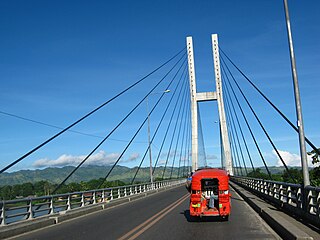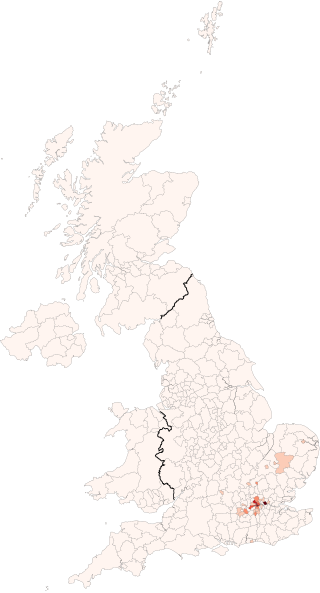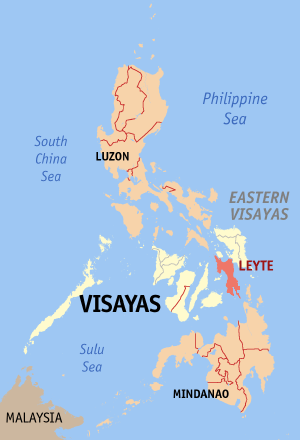
Leyte, officially the Province of Leyte, is a province in the Philippines located in the Eastern Visayas region occupying the northern three-quarters of Leyte Island. Its capital is the city of Tacloban, administered independently from the province. Leyte is thus north of Southern Leyte, south of Biliran, and west of Samar Island. To the west across the Camotes Sea is the province of Cebu.

Ormoc, officially the City of Ormoc, is a 1st class independent component city in the Eastern Visayas region of the Philippines. According to the 2020 census, it has a population of 230,998 inhabitants, making it the second most-populous city in the province of Leyte after the provincial capital of Tacloban. Ormoc is the economic, cultural, commercial and transportation hub of western Leyte.

San Juanico Strait is a narrow strait in the Eastern Visayan region in the Philippines. It separates the islands of Samar and Leyte and connects Carigara Bay with the San Pedro Bay. It is about 38 kilometres (24 mi) long. At its narrowest point, the strait is only 2 kilometers (1.2 mi) wide.

Tacloban, officially the City of Tacloban, is highly urbanized city on Leyte island in the Eastern Visayas region of the Philippines. The city is autonomous from the province of Leyte, although it serves as its provincial capital. According to the 2020 census, Tacloban has a population of 251,881, making it the most populous city in the Eastern Visayas. The city is located 360 miles (580 km) southeast from Manila.

Butuan, officially the City of Butuan, is a 1st class highly urbanized city in the region of Caraga, Philippines. It is the de facto capital of the province of Agusan del Norte where it is geographically situated but has an administratively independent government. According to the 2020 census, it has a population of 372,910 people.

Magallanes, officially the Municipality of Magallanes, is a 4th class municipality in the province of Agusan del Norte, Philippines. According to the 2020 census, it has a population of 22,293 people.

Batac, officially the City of Batac, is a 5th class component city in the province of Ilocos Norte, Philippines. According to the 2020 census, it has a population of 55,484 people.
The legislative districts of Leyte are the representations of the province of Leyte, the independent component city of Ormoc, and highly urbanized city of Tacloban in the various national legislatures of the Philippines. The province, together with the independent cities are currently represented in the lower house of the Congress of the Philippines through their first, second, third, fourth, and fifth congressional districts.

The Philippine International Hot Air Balloon Fiesta is an annual four-day air-sporting event held each year between January and February at the Clark Freeport Zone in Pampanga. It is one of the longest-running aviation sports events in the Philippines. The event attracts more than a hundred balloon pilots around the world, and an estimated 100,000+ visitors locally and from around the world come in to see this event.

Filipinos in the United Kingdom are British citizens or immigrants who are of Filipino ancestry.

Aliwan Fiesta is an annual event that gathers different cultural festivals of the Philippines in Star City Complex in Pasay wherein contingents compete in dance parade and float competitions. Organized by MBC Media Group together with Cultural Center of the Philippines (CCP) and the cities of Manila and Pasay, the event is dubbed as "the Philippines' Grandest Fiesta," with prizes totaling P3 million. Aliwan Fiesta, which began in 2003, aims to showcase the different Filipino cultures and heritage not only to the people in Metro Manila but also to the rest of the world. The contingents, meanwhile, aim to promote their respective regions both economically and tourism-wise. It was originally organized as a visual extravaganza for the Christmas season, but it has since been held during the summer months of either April or May. Aliwan is a Tagalog word for "entertainment" or "amusement." Aliwan Fiesta festivities are covered live on DZRH News Television annually.

The Diocese of Borongan is a Latin Church ecclesiastical jurisdiction or diocese of the Catholic Church in the Philippines. Created on October 22, 1960 by Pope John XXIII from territory of the Diocese of Calbayog, the diocese is a suffragan in the ecclesiastical province of the metropolitan Archdiocese of Palo.

The Pintados Festival is a cultural-religious celebration in Tacloban based on the body-painting traditions of the ancient tattooed "pintados" warriors. In 1986, the Pintados Foundation, Inc. was formed by the people of Tacloban to organize this festival in honor of Sr. Santo Niño. Years later, it was merged with the Kasadyaan Festival which is always held on June 29.

Merlie M. Alunan is a Filipina poet.
Numerous events and festivals are held annually in Metro Manila. They include:
The COVID-19 pandemic in Eastern Visayas is part of the worldwide pandemic of coronavirus disease 2019 caused by severe acute respiratory syndrome coronavirus 2. The virus reached Eastern Visayas on March 23, 2020, when the first case of the disease was confirmed in Northern Samar.
The COVID-19 pandemic in Central Visayas is part of the worldwide pandemic of coronavirus disease 2019 caused by severe acute respiratory syndrome coronavirus 2. The virus reached Central Visayas on February 5, 2020, when the first case of the disease was confirmed in Bohol. As of May 2, 2023, there have been 210,549 cases in Central Visayas with 6,685 deaths.

Leyte–Samar Naval Base was a large United States Navy base in the Philippines on the Islands of Leyte, Samar and the San Pedro Bay. The base was built during World War II to support the many naval ships fighting and patrolling in the South West Pacific theatre of war as part of the Pacific War. A number of naval facilities were built on the east coast of Leyte island starting October 20, 1944. The first base was built at between the city of Tacloban and Anibong Point, a mile north of the city. Headquarters for the Seventh Fleet was built at Tolosa, 10 miles south of Tacloban on Leyte. The bases were on the large San Pedro Bay in Leyte Gulf which provided safe anchorage for many ships. Due to the lack of dry ground in Tacloban a second base was built on the east side of Leyte Gulf, on the south tip of Samar, on Calicoan Island and Tubabao Island. At Samar, a large Naval Depot was built to support the Pacific War. Samar was about 50 miles across Leyte Gulf from Tacloban. All construction was done by the Navy's Seabees.















